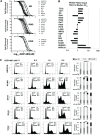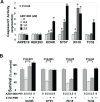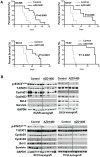Inhibition of STAT3 with orally active JAK inhibitor, AZD1480, decreases tumor growth in Neuroblastoma and Pediatric Sarcomas In vitro and In vivo
- PMID: 23531921
- PMCID: PMC3717306
- DOI: 10.18632/oncotarget.930
Inhibition of STAT3 with orally active JAK inhibitor, AZD1480, decreases tumor growth in Neuroblastoma and Pediatric Sarcomas In vitro and In vivo
Abstract
The IL-6/JAK/STAT pathway is a key signal transduction pathway implicated in the pathogenesis of many human cancers, suggesting that kinase inhibitors targeting JAK/STAT3 may have a broad spectrum of antitumor activity. AZD1480, a pharmacological JAK1/2 inhibitor, exhibits anti-tumor potency in multiple adult malignancies. To evaluate the efficacy of inhibition of JAK/STAT3 signal transduction pathway we assessed the activity of AZD1480 in pediatric malignancies using preclinical models of three highly malignant pediatric solid tumors: neuroblastoma (NB), rhabdomyosarcoma (RMS) and the Ewing Sarcoma Family Tumors (ESFT). In this study, we employed panels of biomedical and biological experiments to evaluate the in vitro and in vivo activity of AZD1480 in NB, RMS and ESFT. Our data indicate that AZD1480 blocks endogenous as well as IL-6 induced STAT3 activation. AZD1480 decreases cell viability in 7/7NB, 7/7RMS and 2/2 ESFT cell lines (median EC50 is 1.5 μM, ranging from 0.36-5.37 μM). AZD1480 induces cell growth inhibition and caspase-dependent apoptosis in vitro and decreases expression of STAT3 target genes, including cell cycle regulators CyclinD1, 3 and CDC25A, anti-apoptotic genes Bcl-2 and survivin, the metastasis-related factor TIMP-1 and c-Myc. In vivo studies showed AZD1480 significantly decreased tumor growth and prolonged overall survival in tumor-bearing mice. Tumors from AZD1480-treated mice showed inhibition of activated STAT3 as well as decreased expression of STAT3 downstream targets. Our study provides strong evidence of the anti-tumor growth potency of JAK inhibitor AZD1480 in pediatric solid tumors, providing proof-of principle that inhibition of the JAK/STAT3 signal transduction could be a promising therapeutic target for high-risk pediatric solid tumors.
Conflict of interest statement
Authors have no conflict of interests
Figures






Similar articles
-
The novel JAK inhibitor AZD1480 blocks STAT3 and FGFR3 signaling, resulting in suppression of human myeloma cell growth and survival.Leukemia. 2011 Mar;25(3):538-50. doi: 10.1038/leu.2010.289. Epub 2010 Dec 17. Leukemia. 2011. PMID: 21164517 Free PMC article.
-
JAK kinase inhibition abrogates STAT3 activation and head and neck squamous cell carcinoma tumor growth.Neoplasia. 2015 Mar;17(3):256-64. doi: 10.1016/j.neo.2015.01.003. Neoplasia. 2015. PMID: 25810010 Free PMC article.
-
Pharmacologic inhibition of Jak2-Stat5 signaling By Jak2 inhibitor AZD1480 potently suppresses growth of both primary and castrate-resistant prostate cancer.Clin Cancer Res. 2013 Oct 15;19(20):5658-74. doi: 10.1158/1078-0432.CCR-13-0422. Epub 2013 Aug 13. Clin Cancer Res. 2013. PMID: 23942095 Free PMC article.
-
Synthetic Heterocyclic Derivatives as Kinase Inhibitors Tested for the Treatment of Neuroblastoma.Molecules. 2021 Nov 23;26(23):7069. doi: 10.3390/molecules26237069. Molecules. 2021. PMID: 34885651 Free PMC article. Review.
-
Targeting B7-H3-A Novel Strategy for the Design of Anticancer Agents for Extracranial Pediatric Solid Tumors Treatment.Molecules. 2023 Apr 11;28(8):3356. doi: 10.3390/molecules28083356. Molecules. 2023. PMID: 37110590 Free PMC article. Review.
Cited by
-
Mutant Proteomics of Lung Adenocarcinomas Harboring Different EGFR Mutations.Front Oncol. 2020 Aug 25;10:1494. doi: 10.3389/fonc.2020.01494. eCollection 2020. Front Oncol. 2020. PMID: 32983988 Free PMC article.
-
Cancer prevention and therapy through the modulation of the tumor microenvironment.Semin Cancer Biol. 2015 Dec;35 Suppl(Suppl):S199-S223. doi: 10.1016/j.semcancer.2015.02.007. Epub 2015 Apr 10. Semin Cancer Biol. 2015. PMID: 25865775 Free PMC article. Review.
-
Anti-tumor activity of miR-17 in melanoma.Cell Cycle. 2015;14(16):2549-50. doi: 10.1080/15384101.2015.1006545. Epub 2015 Jan 15. Cell Cycle. 2015. PMID: 25590495 Free PMC article. No abstract available.
-
Withaferin A Inhibits STAT3 and Induces Tumor Cell Death in Neuroblastoma and Multiple Myeloma.Biochem Insights. 2014 Nov 9;7:1-13. doi: 10.4137/BCI.S18863. eCollection 2014. Biochem Insights. 2014. PMID: 25452693 Free PMC article.
-
Cryptotanshinone enhances the effect of Arsenic trioxide in treating liver cancer cell by inducing apoptosis through downregulating phosphorylated- STAT3 in vitro and in vivo.BMC Complement Altern Med. 2017 Feb 10;17(1):106. doi: 10.1186/s12906-016-1548-4. BMC Complement Altern Med. 2017. PMID: 28187727 Free PMC article.
References
-
- Matthay KK, Villablanca JG, Seeger RC, Stram DO, Harris RE, Ramsay NK, Swift P, Shimada H, Black CT, Brodeur GM, Gerbing RB, Reynolds CP. Treatment of high-risk neuroblastoma with intensive chemotherapy, radiotherapy, autologous bone marrow transplantation, and 13-cis-retinoic acid. Children's Cancer Group. N Engl J Med. 1999;341:1165–1173. - PubMed
-
- Leavey PJ, Collier AB. Ewing sarcoma: prognostic criteria, outcomes and future treatment. Expert Rev Anticancer Ther. 2008;8:617–624. - PubMed
Publication types
MeSH terms
Substances
Grants and funding
LinkOut - more resources
Full Text Sources
Other Literature Sources
Medical
Molecular Biology Databases
Research Materials
Miscellaneous

